As people draw away from basing their fitness goals only on weight, 3D body scanning has grown in popularity. Many gyms and personal trainers offer body scanning as part of progress tracking.
People prefer body scanning because it allows them to get a deeper picture of what’s going on inside their bodies. Instead of basing their goals simply on weight, people can base their goals on body fat percentage and muscle mass growth.
Different body scanners work to measure parts of the body and use their specific equations to determine body fat percentage.
One other very popular body scanner is InBody. Let’s see how it differs from Styku for 3D body scanning.
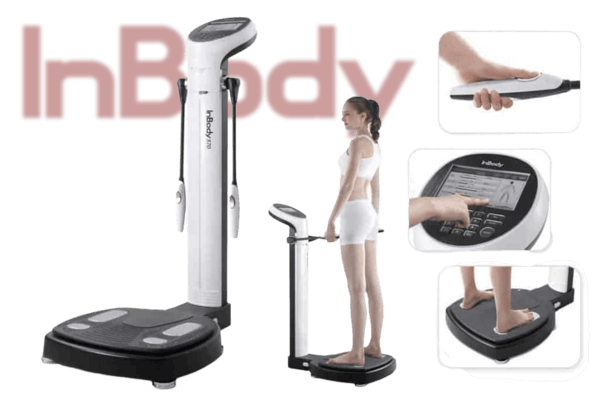
How the InBody Machine Works
The InBody uses bioelectrical impedance analysis (BIA) to measure people’s body fat, muscle mass, and body water.
BIA works by sending small electrical currents through the body with electrodes and measuring the impedance it gets in return.
How BIA Measures Body Fat
Through a combination of measuring resistance and reactance, BIA determines what percentage of the body is fat, muscle, and bone. It does this by measuring the amount of water in certain parts of the body.
Water is very conductive, so the more water there is in a part of the body the easier the electric current can move through it. Muscle holds more water than fat. So, if a current moves easily, that means there is more muscle. On the other hand, if the current finds resistance, it’s because of fat in the body.
BIA machines like InBody use that information to measure a person’s body fat percentage.
InBody uses eight electrode spots to measure resistance. There are two spots positioned on each hand and foot, which makes it easy to use for repeat scans in gyms or offices.
Complimentary to BIA Measurements
Most methods of BIA measuring involved taking a person’s weight, age, and other factors into consideration because water resistance measurements weren’t as accurate.
InBody still uses these methods, but scan accuracy mostly is attributed to multiple points of electrodes and multi-frequency measurements without using other biased personal factors.
Who Is InBody For?
InBody tests tell you what your weight means, as opposed to simply how much you weigh. It helps you to understand your weight and get a more accurate idea of your health.
Many personal trainers and fitness experts track their clients’ health and progress through body percentages. That way, people can easily focus on fat loss and muscle gain percentages, rather than simply weight loss.
Personal trainers, nutritionists, and healthcare professionals can use InBody scan results to make their programs as effective as possible.
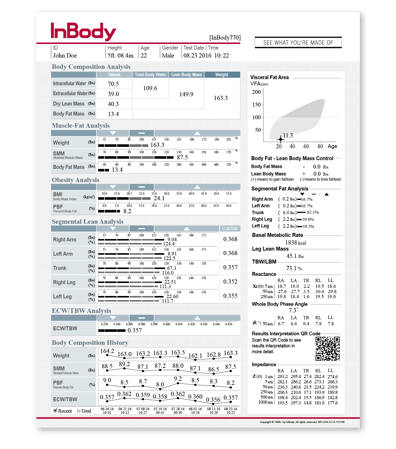
Understanding InBody Results: Composition Analysis
For body composition analysis, InBody measures the value of different parts of the body, which is a result that gives the person’s weight.
InBody gives the value of total body water (TBW), protein, minerals, body fat, and total weight. InBody determines how much of your body weight is water, which usually accounts for 60% of the total body weight.
Protein is an important part of muscle growth, so a lack of protein in the body usually means a lack of muscles or poor nutrition.
InBody measures two kinds of minerals. One kind of mineral is in bone mass, and the other mineral is in all other parts of the body. By looking at these values, you can determine if bone minerals are too low, which is a sign associated with osteoporosis.
Understanding Muscle to Fat Ratio Analysis Results
People who use InBody to track their weight loss progress, appreciate getting the muscle to fat ratio measurements. BMI measurements alone don’t give the most accurate depiction of a person’s true weight.
For example, since muscle weighs more than fat, someone with a lot of muscle and little body fat could be considered overweight by BMI standards. With InBody results, you can see what your total body weight means.
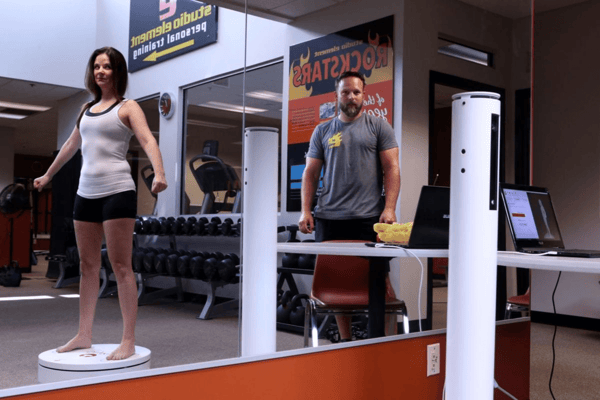
How Does Styku 3D Scanning Work?
Styku machines do not use the same BIA measurements as the InBody. Instead, the machine takes multiple infrared scans within a few seconds to form a virtual 3D model of your body.
Styku measures body circumference and uses a complex equation to calculate an accurate prediction of body fat percentage. The equation Styku uses comes from scan comparisons done with DEXA scans.
DEXA scanners are the most accurate depiction of body composition that’s easier to access than a CAT scan and not as evasive as bloodwork. In one test, hundreds of participants got DEXA body composition scans and Styku circumference scans.
Each scanning method predicted body fat percentage, and testers compared the results. Through these comparisons, testers found correlations between DEXA scans and body circumference scans.
Now, a Styku body scan gives you a body composition result that’s comparable to the result you’d get from a DEXA scan. Only, a Styku scan takes only 35 seconds to complete. It saves consumers time and money without sacrificing knowledge.
What’s a Styku Scan Involve?
Getting a Styku scan is easy. As mentioned before, it takes less than a minute to complete. To complete a scan, you stand on the Styku turntable in a relaxed stance with your hands slightly out the side.
The turntable rotates a few times while it takes 600 infrared images. These images contribute to an inclusive 3D model that includes body composition. Then, customers can see how the circumference of their body has changed over time.
Who is Styku Scanning For?
Styku is a great tool for tracking personal progress. The 3D body scans allow for customers to get a better perspective on how much their body has changed since they started working out or eating healthier.
With the advantage of seeing themselves from the outside, individuals maintain motivation and continue to make progress. For that reason, the Styku is a perfect addition to any gym, especially one with personal training programs.
Many gyms find that customers appreciate training programs that offer body scanning to track progress.
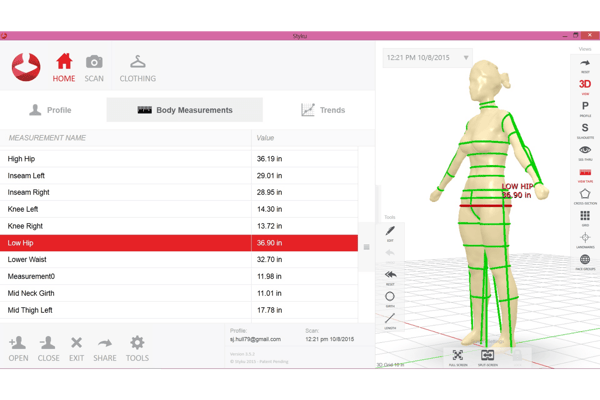
Understanding Styku Scanner Results
Styku results present themselves in 3D form. But, it also offers recommendations for how to improve body fat percentage.
The body fat analysis results let clients compare their body fat percentage to others in their same age and gender category.
There’s also a scan history section that allows customers to see a graph that documents each of their scans and the dates. They can also see side by side comparisons of each of their 3D scans.
The Styku system also lets customers set body fat percentage loss goals for themselves. Once they set a goal, the system will give them an estimated date for when they’ll complete their goal at the rate they’re currently going.
Along with setting fat loss goals, the scanner also gives customers an idea of what their calorie intake should be each day to meet their goals. Styku gives you a calorie intake based on how much energy it expects you to expend.
It’s a great motivational tool because it allows clients to see first hand that if they don’t stick to their rules, they won’t reach their goals how they want to.
What Body Scanners Cannot Do
Getting a better picture of your body composition helps with training and progress tracking. But, it’s important to note that body scanners don’t give a full health picture. They don’t supplement for regular doctor visits and health screenings.
There’s no health scanner on the market other than a CAT scan that gives healthcare professionals enough information to diagnose and treat health concerns.
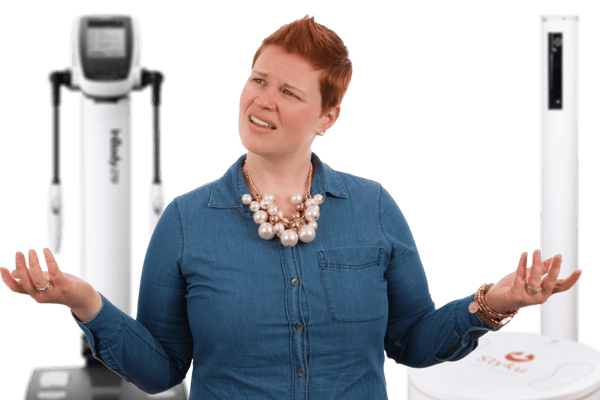
InBody vs. Styku: Which is Right for You?
If you’re considering purchasing a body scanner for your clients or personal use, the right machine makes a big difference. InBody machines are great for people working with a focus on nutrition. On the other hand, Styku scanners offer many features that personal trainers and gym users appreciate.
InBody scanners offer great comprehensive body information that works well in addition to other medical tests and scans. Styku focuses more on the individual goals and perspectives of clients.
Anyone with an electronic device, such as a pacemaker, can’t use the InBody scanner because it could disrupt the device’s functions. On the other hand, Styku uses harmless infrared lights. So there’s no risk of harming someone with its use.
No matter which machine is the best for your business or personal use, they both offer great features that everyone finds beneficial to meeting their health goals.
Find a Styku Scanner Near You
Many gyms around the country have already implemented 3D body scanners for their clients. You can visit the Styku website here for a map of gyms in your area with access to a Styku body scanner.
The differences between Styku 3D body scanners and InBody scanners make for different use-cases. Hopefully, this article helped you determine which machine is right for you.
For more information about acquiring a Styku 3D body scanner at your gym, contact us.






